The Northern Hawk-Owl (Surnia ulula) is a captivating and enigmatic bird of prey, that inhabits the boreal forests of North America, Europe, and Asia.
Recognized for its distinctive appearance and hunting techniques, this medium-sized owl stands out with its sleek plumage, marked facial disk, and piercing yellow eyes.
Unlike typical owls, the Northern Hawk-Owl exhibits diurnal behavior, making it an exceptional daytime hunter.
With a preference for open habitats such as tundra, meadows, and clearings, it is known to perch conspicuously on tree branches, scanning the surroundings for prey.
Equipped with exceptional vision and acute hearing, this species preys on small mammals, birds, and insects.
The Northern Hawk-Owl’s adaptability to diverse environments and its ability to navigate through the vast landscapes of the northern hemisphere contribute to its status as a fascinating and resilient bird in the avian kingdom.
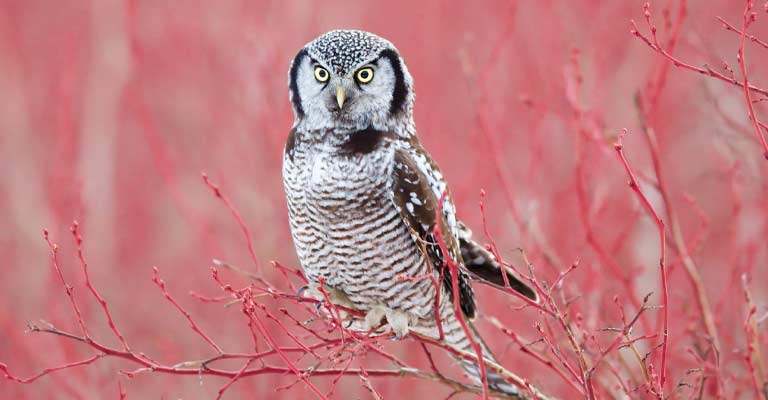
Identifying Characteristics of Northern Hawk-Owl
The Northern Hawk-Owl (Surnia ulula) possesses a unique set of identifying characteristics that distinguish it from other owl species.
Observing these features can greatly aid birdwatchers and enthusiasts in accurately identifying this captivating raptor.
Distinctive Plumage
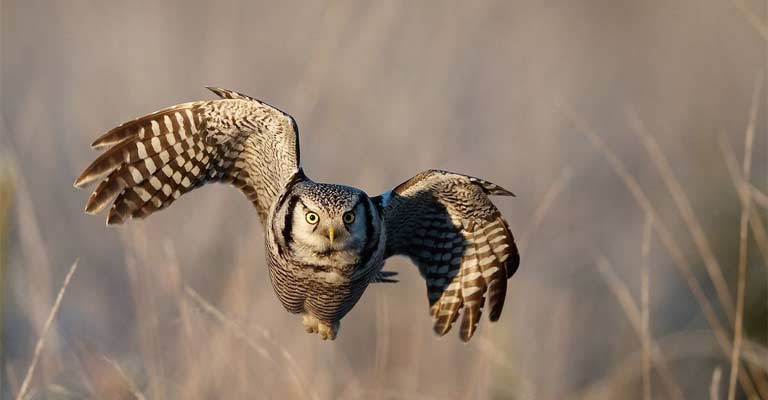
The Northern Hawk-Owl’s plumage is a key identifying feature. Characterized by a mix of mottled dark brown and white feathers, the bird exhibits a strikingly sleek and streamlined appearance.
The plumage helps it blend seamlessly with the northern boreal forests it calls home.
Facial Disk Markings
Unlike many owls, the Northern Hawk-Owl boasts a well-defined facial disk with contrasting dark markings around its eyes. This facial disk enhances sound reception, a crucial adaptation for its diurnal hunting behavior.
Yellow Eyes
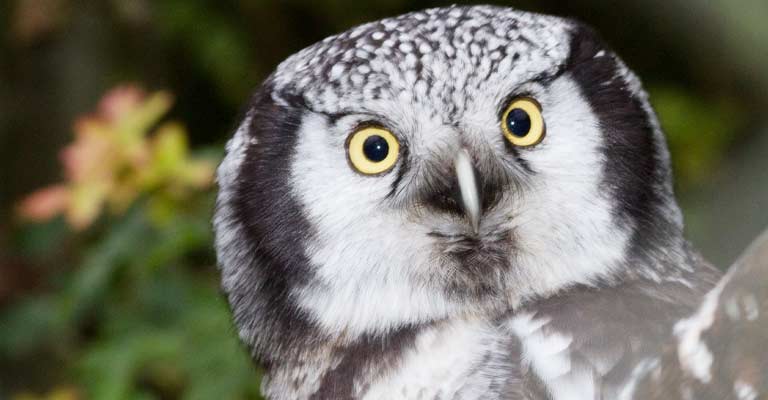
The intense yellow coloration of its eyes is a prominent feature. These piercing eyes contribute to the bird’s keen eyesight, allowing it to spot prey from a considerable distance during daylight hours.
Long, Tapered Tail
One of the most distinctive physical traits of the Northern Hawk-Owl is its long and tapered tail. This feature, combined with its agile flight, aids in precise aerial maneuvers and enhances its hunting capabilities.
Size and Shape
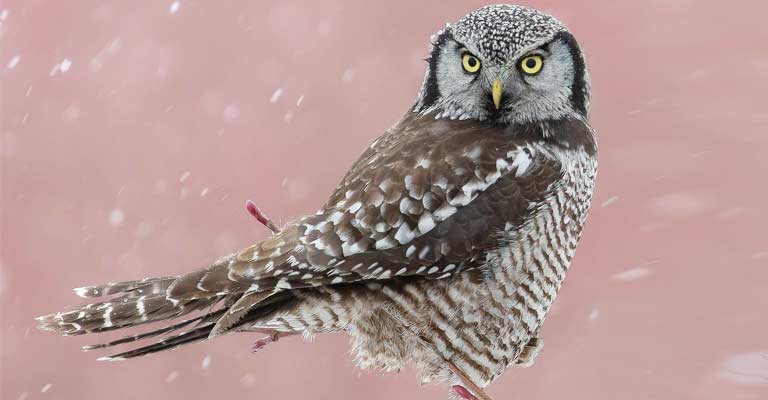
Medium-sized among owls, the Northern Hawk-Owl is slender and elongated in appearance.
Its size, coupled with a long tail and rounded wings, sets it apart from other owl species, particularly those with more robust builds.
Diurnal Behavior
Unlike the nocturnal habits of many owls, the Northern Hawk-Owl is diurnal, meaning it is active during the day. This behavioral characteristic is essential for identifying the species as it hunts, perches, and displays its unique features in daylight.
Preferred Habitats
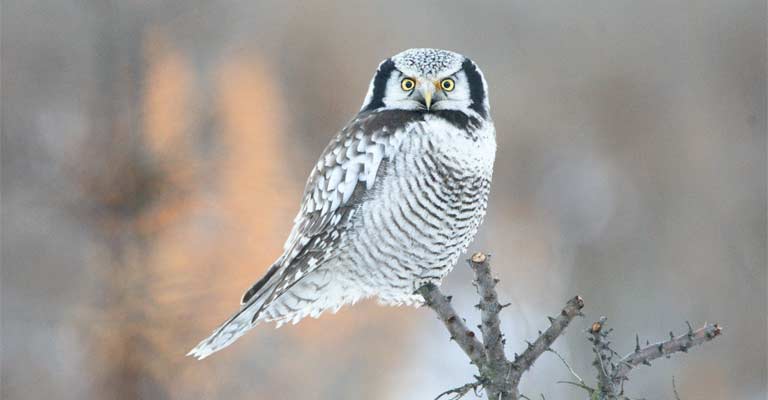
Understanding the bird’s habitat preferences is crucial for identification. The Northern Hawk-Owl favors open landscapes such as meadows, clearings, and tundra.
Observing its presence in these environments provides a valuable clue for identification.
Distinctive Calls
While visual cues are essential, recognizing the Northern Hawk-Owl’s vocalizations can further confirm its presence.
It produces a series of high-pitched, piercing calls distinct from the hoots commonly associated with other owl species.
The Northern Hawk-Owl’s identifying characteristics encompass its plumage, facial disk markings, yellow eyes, long tail, size, diurnal behavior, habitat preferences, and vocalizations.
A holistic understanding of these features enhances the chances of accurate identification, allowing birdwatchers to appreciate the unique attributes of this remarkable raptor in its natural habitat.
Taxonomy of Northern Hawk-Owl
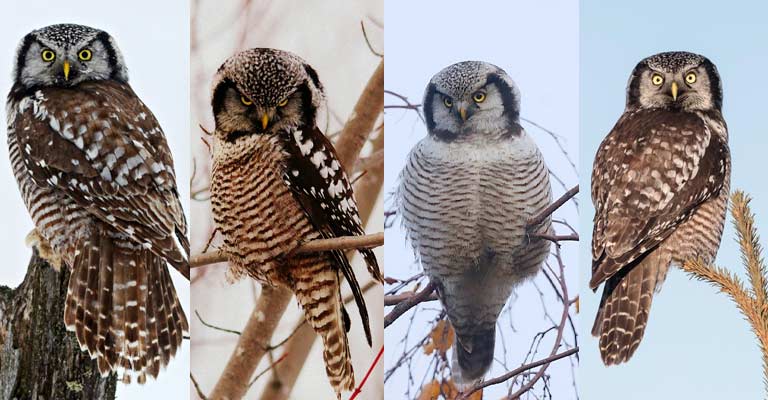
This table will summarize the taxonomy details of the Northern Hawk-Owl:
| Taxonomic Rank | Classification |
| Domain | Eukaryota |
| Kingdom | Animalia |
| Phylum | Chordata |
| Class | Aves |
| Order | Strigiformes |
| Family | Strigidae |
| Genus | Surnia |
| Species | S. ulula |
The Northern Hawk-Owl (Surnia ulula) is a species with distinct geographic variations, exhibiting subtle yet important differences across its range.
Three subspecies, each adapted to its specific environment, contribute to the diversity of this captivating bird.
S. u. tianschanica (Central Asia to Northern China and Mongolia)
This subspecies is found in the expansive region stretching from Central Asia to northern China and Mongolia. Birds belonging to this group display adaptations to the unique climatic and ecological conditions of central Asia.
The plumage may reflect subtle variations and behavioral traits could differ based on the challenges posed by the terrain and climate of this vast area.
S. u. ulula (Northern Eurasia)
The nominate subspecies, S. u. ulula, is distributed across the northern regions of Eurasia.
Encompassing diverse habitats such as the boreal forests and tundra, this subspecies has adapted to the specific environmental conditions prevalent in the northern reaches of the Eurasian continent.
The plumage and physical characteristics of individuals within this subspecies may reflect adaptations to the varied landscapes they inhabit.
S. u. caparoch (Northern North America)
Occupying the northern regions of North America, the S. u. caparoch subspecies is well-adapted to the boreal forests and open landscapes of this continent. Its range extends across northern North America, where it encounters diverse ecosystems.
Behavioral patterns and physical traits of these birds may exhibit variations reflecting the unique challenges and opportunities presented by the North American environment.
Despite these regional differences, all three subspecies of the Northern Hawk-Owl share core characteristics that define the species.
These include diurnal hunting behavior, a distinctive facial disk, yellow eyes, a long and tapered tail, and a preference for open habitats. These common features align with the species’ overall adaptive strategy for successful predation in a variety of northern ecosystems.
Northern Hawk-Owl Life History
The Northern Hawk-Owl (Surnia ulula) stands as a remarkable avian predator inhabiting the boreal forests of North America, Europe, and Asia.
Its life history unfolds through a tapestry of unique adaptations, behaviors, and challenges, reflecting the species’ resilience in diverse ecosystems.
From its distinctive hunting techniques to nesting behaviors and conservation concerns, each facet contributes to the intricate narrative of the Northern Hawk-Owl’s existence.
Food
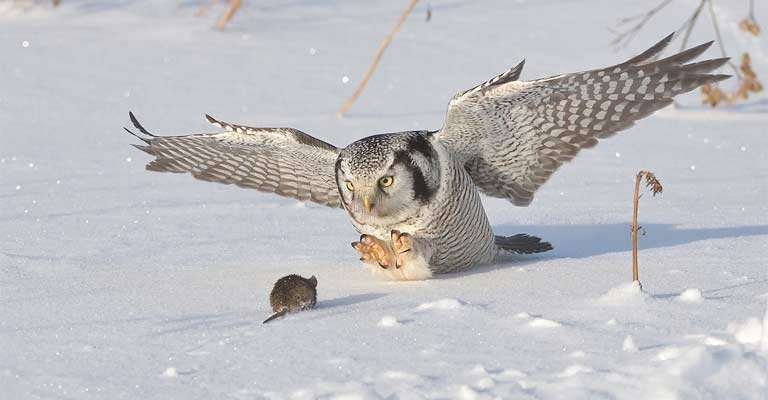
The Northern Hawk-Owl is an opportunistic predator with a diverse diet. Its primary prey includes small mammals, such as voles, shrews, and mice, along with birds and insects.
Remarkably, this diurnal hunter relies on keen vision and acute hearing to locate prey, often perching conspicuously before making precise aerial descents to capture its quarry.
Habitat
Preferring open landscapes, the Northern Hawk-Owl thrives in habitats like tundra, meadows, and clearings. Its adaptability allows it to navigate through vast northern forests, choosing areas with suitable prey populations.
This versatility in habitat selection contributes to its widespread distribution across North America, Europe, and Asia.
Range Map
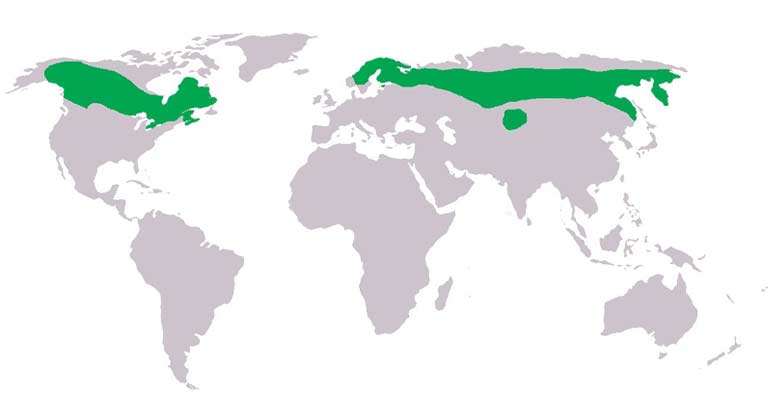
The species exhibits a broad geographic range, with distinct subspecies occupying specific regions.
A range map illustrates the distribution of Surnia ulula, depicting the areas where its various subspecies, such as S. u. tianschanica in central Asia, S. u. ulula in northern Eurasia, and S. u. caparoch in northern North America, can be found.
Nesting and Breeding
Northern Hawk-Owls construct nests in trees, often reusing abandoned crow or hawk nests. Females lay a clutch of eggs, typically ranging from 3 to 11, depending on factors like prey availability.
Incubation lasts about 25 to 30 days, with both parents participating in caring for the young. The fledglings become independent within a few months, marking the culmination of the breeding season.
Here’s a table summarizing nesting details for the Northern Hawk-Owl (Surnia ulula):
| Nesting Details | Northern Hawk-Owl (Surnia ulula) |
| Clutch Size | 3 to 11 eggs |
| Number of Broods | Typically one per breeding season |
| Egg Length | Approximately 4.2 cm (1.7 inches) |
| Egg Width | Approximately 3.5 cm (1.4 inches) |
| Incubation Period | 25 to 30 days |
| Nestling Period | About 28 to 35 days |
| Egg Description | Oval-shaped, white with minimal markings |
| Nest Type | Often reuse abandoned crow or hawk nests in trees |
| Nest Location | Placed in coniferous or deciduous trees |
| Parental Involvement | Both parents participate in incubation and care |
| Fledgling Independence | Young become independent within a few months |
Diseases and Treatment
While the Northern Hawk-Owl is generally hardy, it may face health challenges, including avian diseases. Avian veterinarians and wildlife rehabilitators play a crucial role in diagnosing and treating illnesses.
Monitoring local populations and addressing potential threats such as habitat loss contribute to preventive measures for the species.
Conservation
Conservation efforts for the Northern Hawk-Owl focus on preserving its habitat and mitigating human-induced threats. Habitat destruction, climate change, and logging pose significant risks.
Collaborative initiatives involving researchers, conservation organizations, and communities strive to safeguard the species by promoting sustainable land use practices and raising awareness about the importance of preserving its unique ecosystems.
The Northern Hawk-Owl’s conservation status emphasizes the need for continued vigilance and concerted actions to ensure its survival in the wild.
10 Surprising Facts About Northern Hawk-Owl
The Northern Hawk-Owl (Surnia ulula) is a captivating bird of prey that reveals a host of intriguing characteristics, setting it apart from conventional owl species.
This diurnal hunter inhabits the expansive boreal forests of North America, Europe, and Asia. Delve into the world of the Northern Hawk-Owl with these ten surprising facts that illuminate its unique attributes.
- Daytime Predator: Unlike most owls that are nocturnal, the Northern Hawk-Owl is primarily diurnal, showcasing its hunting prowess during daylight hours. This adaptation allows it to exploit a niche of hunting opportunities unavailable to its nocturnal counterparts.
- Distinctive Facial Disk: The bird possesses a well-defined facial disk with dark markings around its eyes, contributing to its exceptional hearing abilities. This adaptation enhances its capacity to locate prey even in the daylight.
- Nomadic Lifestyle: The Northern Hawk-Owl is known for its nomadic tendencies. Driven by fluctuations in prey populations, it can travel great distances in search of optimal hunting grounds, making it a true wanderer of the boreal landscape.
- Varied Vocalizations: In addition to its distinctive appearance, the Northern Hawk-Owl produces a variety of vocalizations. These include high-pitched calls, shrieks, and hissing sounds, serving both communicative and territorial purposes.
- Agile Flight: With a slender build, long tail, and rounded wings, the Northern Hawk-Owl exhibits remarkable agility in flight. This aerial prowess aids in navigating through dense forests and capturing agile prey.
- Multiple Subspecies: The species comprises several subspecies, each adapted to specific regions. From central Asia to northern China and Mongolia (S. u. tianschanica) to northern North America (S. u. caparoch), these subspecies showcase the bird’s ability to thrive in diverse environments.
- Selective Mating Sites: Northern Hawk-Owls are selective when it comes to nesting sites. They often repurpose abandoned nests of crows or hawks, showcasing resourcefulness in utilizing existing structures.
- Variable Clutch Size: The species displays variability in clutch size, ranging from 3 to 11 eggs. This adaptability allows Northern Hawk-Owls to adjust their reproductive output based on environmental conditions.
- Boreal Habitat Specialist: Thriving in boreal forests, the Northern Hawk-Owl is a specialist in these habitats. Its plumage and behaviors are finely tuned to the challenges and opportunities presented by the northern coniferous landscapes.
- Climate-Resilient Species: Adapted to harsh northern climates, the Northern Hawk-Owl showcases resilience in the face of inclement weather. Its ability to endure cold conditions and navigate vast, snowy landscapes makes it a true symbol of adaptability in the avian world.
In essence, the Northern Hawk-Owl unfolds as a captivating species with a portfolio of surprising traits, contributing to its unique niche in the intricate tapestry of the northern boreal ecosystems.
Wrapping Up
In the enigmatic world of the Northern Hawk-Owl, each feather tells a story of adaptability, resilience, and surprising behaviors.
From its diurnal hunting habits and nomadic lifestyle to its distinct vocalizations and selective nesting preferences, this remarkable bird captivates enthusiasts and scientists alike.
The Northern Hawk-Owl’s ability to thrive in the vast boreal landscapes of North America, Europe, and Asia underscores its ecological significance.
As we unravel its secrets, we gain not only a deeper understanding of a unique species but also insights into the delicate balance of nature in the northern reaches of our planet.